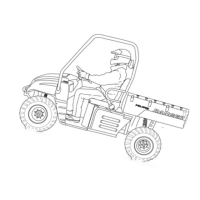9926595 R01 - 2015-2016 RANGER EV Service Manual
© Copyright Polaris Industries Inc.
1.3
SPECIAL INFORMATION REGARDING THE RANGER EV
OPERATING THE RANGER EV
If you are not familiar with the controls, features, or safe
operation of RANGER EV vehicles, read the Owner’s
Manual thoroughly before you operate the vehicle.
If you are an experienced RANGER EV technician and
have read and become familiar with safe vehicle
operation, a basic description of the switches and
controls unique to the RANGER EV is included in this
manual.
WORKING ON THE RANGER EV
Improper contact between battery terminals can result in
electrical shorts. Electrical shorts can result in burns.
WARNING
Use insulated tools or insulate any tools used within the
battery area to prevent sparks or battery explosion
caused by shorting the battery terminals or wiring.
Remove the batteries or cover the exposed terminals
with an insulating material.
The RANGER EV is equipped with eight 12-volt lead/acid
batteries arranged in two banks of four batteries each.
Each bank of batteries delivers 48 volts to a high
efficiency AC induction motor via the motor controller unit
and a key switch-controlled main contactor. Batteries,
controller, and contactor are located under the seat. Here
are a few key differences to remember when working on
the RANGER EV.
48 VOLT FUSES AND RELAYS
Be aware that some of the fuses and relays on the
RANGER EV are 48 volt; they may look similar to their 12
volt counterparts, but they are not the same and must not
be substituted with other types. The fuse voltage and
current rating is clearly marked on the fuse box label.
Refer to Chapter 8 of this manual (Electrical) for more
information and diagnostics for electrical system
components. Battery information is in this chapter
(Chapter 1).
GENERAL SAFETY REMINDERS
Wear the proper protective gear. Shield your eyes when
working on the RANGER EV.
Working on or around lead-acid batteries can be
dangerous if you do not take precautions and follow
proper handling, charging, and service procedures while
you work. Read the entire BATTERY SAFETY section of
this manual.
Remove all jewelry or metal objects that could come in
contact with battery terminals as you work in or around
the battery compartment; including (but not limited to):
• Rings, chains, wrist watches, bracelets, etc.
If battery access is not required for the task at hand,
keep storage trays and the seat in place to reduce the
chance of a dropped tool or other conductive object
making contact with the battery cables or terminals.
MAIN POWER CONNECTOR / BATTERY CHARGER
Some service procedures require special precautionary
steps to reduce the chance of electrical shorts and avoid
damage to expensive components. Always read and
understand the entire procedure and be sure you have
the proper tools and equipment before you begin. DO
NOT disconnect or work on any electrical component
without first disconnecting the Main Power Connector.
See Main Power Connector, page 1.20. DO NOT work on
the vehicle with the battery charger connected.
“FLOATING” CHASSIS
The RANGER EV frame and other chassis components
ARE NOT used as a conductor (ground path) for
electrical components and therefore not at ground
potential. NEVER connect accessories or other wiring to
the frame or chassis. Accessory Installation Precautions,
page 1.33. NEVER work on the vehicle with the battery
charger connected.
TIRE PRESSURE
Tire pressure for all tires is 20 psi (138 kPa) due to the
tire design used on the RANGER EV.
VEHICLE TOWING
CAUTION
When towing the vehicle, the key MUST be in the OFF
position or severe motor damage will occur.
1. Place direction selector in NEUTRAL
2. Turn key switch OFF.
3. Verify the parking brake is not engaged.
GENERAL / BATTERY
1

